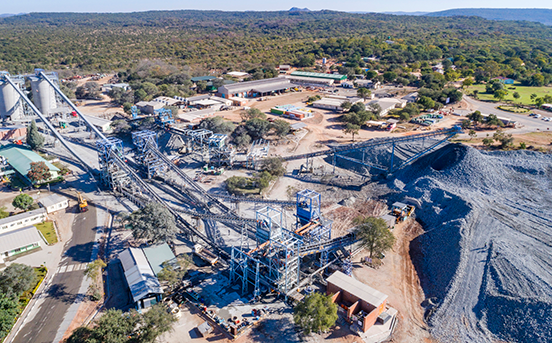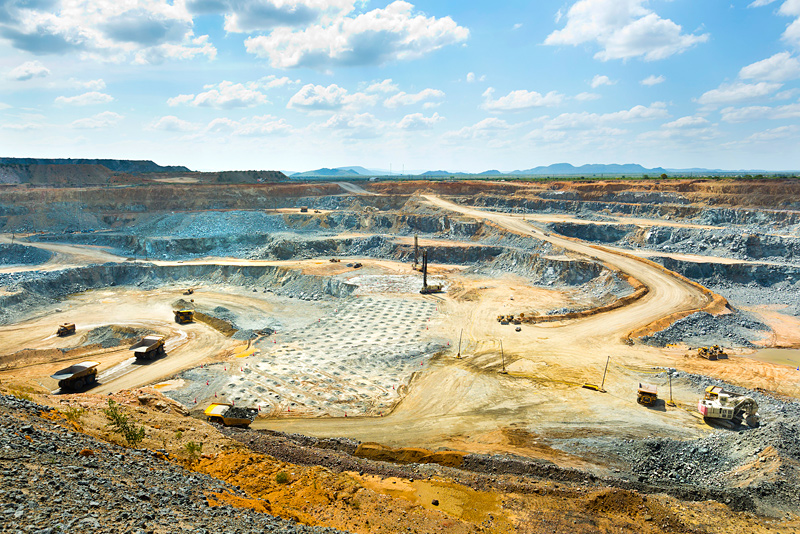Mining in Rustenburg: Driving South Africa’s Economy
Eric Walker
November 05, 2023Welcome to our exploration of Rustenburg, South Africa’s economic powerhouse, where mining takes center stage. This region’s rich mineral deposits have propelled the nation’s economy, contributing significantly to its growth and development. Let’s delve into how Rustenburg’s mining industry helps drive South Africa’s economic momentum.
History of Mining in Rustenburg
Rustenburg, situated in the North West Province of South Africa, has a rich history of mining that dates back to the 17th century. The city is notably famous for its platinum reserves, the largest in the world, and historically known for its generous deposits of various other minerals.
The history of mining in Rustenburg is intertwined with the discovery of the Merensky Reef by geologist Hans Merensky in 1924. The reef is a rich source of Platinum Group Metals (PGMs), comprising platinum, palladium, rhodium, iridium, osmium, and ruthenium. This discovery set the stage for an economic boom in Rustenburg, transforming it into a city of significance in South Africa’s mining landscape.
By the late 20th century, Rustenburg had become a hub for platinum mining. Major mining companies, including Anglo American Platinum and Impala Platinum, established their operations in the city. These mining companies played a pivotal role in shaping Rustenburg’s economy and infrastructure, leading to an increase in employment opportunities and overall development.
Mining Challenges in Rustenburg
However, mining in Rustenburg has not been without challenges. Over the years, the sector has been plagued by labor unrest, environmental concerns, and fluctuating commodity prices. The Marikana massacre in 2012, which resulted in the death of 34 miners during a wildcat strike at Lonmin’s Marikana operations, underscored the deep-seated issues within Rustenburg’s mining industry.
Despite these challenges, mining continues to be a crucial part of Rustenburg’s economy. Recent advancements in mining technology have opened new prospects for efficient and sustainable mining practices. The city’s rich mineral wealth continues to attract investment, ensuring Rustenburg’s place as a vital player in South Africa’s mining sector.
Today, Rustenburg stands as a testament to the trials and triumphs of mining. Its history offers valuable lessons on balancing economic progress with social responsibility and environmental stewardship. As we look towards the future, these lessons will be crucial for shaping a more sustainable and inclusive mining industry.
Platinum Capital of the World
Rustenburg, a city nestled in the heart of South Africa’s North West Province, possesses a unique claim to fame. It is globally recognized as the ‘Platinum Capital of the World‘, a title that speaks volumes about its rich mineral wealth.
The city is primarily known for its extensive platinum reserves, which are the largest in the world. Since the discovery of this precious metal in the area, mining has become the lifeblood of Rustenburg, shaping its economic landscape and influencing its cultural identity.
The city is home to two of the largest platinum mines globally – the Impala Platinum Mine and the Anglo American Platinum Mine. Together, these mines contribute significantly to South Africa’s platinum production, making it one of the top platinum producers globally.
Impala Platinum Mine
The Impala Platinum Mine, owned by Impala Platinum Holdings (Implats), is located just north of Rustenburg and is one of the most productive platinum mines globally. With over 16 shafts and an extensive mining complex, this mine contributes significantly to South Africa’s platinum output.
Anglo American Platinum Mine
The Anglo American Platinum Mine, known as Amplats, is another significant player in Rustenburg’s platinum mining industry. Amplats operates several mines in the region, including the Mogalakwena Mine, which is one of the most cost-effective platinum mines in the world.
The mining industry in Rustenburg is centered around platinum group metals (PGMs), which include platinum, palladium, rhodium, iridium, ruthenium, and osmium. These metals are highly valuable for their exceptional resistance to wear and tarnish, making them vital in numerous industries such as jewellery, automotive, and electronics.
Rustenburg’s platinum mines are massive operations, employing thousands of workers and contributing significantly to the local and national economy. The city’s mining history is deeply intertwined with the growth and development of South Africa as a whole.
However, mining in Rustenburg is not just about extraction. The city is also at the forefront of innovative mining techniques and sustainable practices. The industry’s leaders are continually seeking ways to minimize their environmental footprint and ensure that their operations benefit the local community.
Rustenburg’s status as the Platinum Capital of the World isn’t just a testament to its geological luck; it’s a reflection of the hard work, innovation, and resilience of its people. They have turned a landscape rich in mineral wealth into a thriving city, proving that with the right resources and determination, even the most challenging environments can become prosperous and vibrant communities.
Economic Impact of Mining in Rustenburg
The city’s economy is heavily dependent on mining activities, which significantly contribute to both its local and national GDP.
The region is rich in platinum group metals (PGMs), and is home to two of the largest platinum mines in the world. They are the Impala and Anglo American Platinum. These mines not only contribute significantly to Rustenburg’s economy but also play a pivotal role in South Africa’s overall mining output.
The mining industry provides direct and indirect employment opportunities for a large portion of Rustenburg’s population. Many individuals work directly in the mines or in related industries such as machinery manufacturing, transport, and other support services. Moreover, the wages and salaries of these workers circulate within the local economy, stimulating growth in other sectors such as retail, housing, and education.
There are many leading Engineering schools offering Mining Programs. Mining Schools has become a part of such Engineering programs offering both MS and Phd degrees. The Industry is going through transformation with many automation and technology adoption happening.
Moreover, Rustenburg’s mining sector attracts substantial foreign direct investment (FDI), enhancing infrastructure development, technology transfer, and skills development within the region. The FDI also helps to maintain a steady flow of foreign exchange into the country, bolstering South Africa’s balance of payments.
Despite the significant economic benefits, it’s essential to note that mining also poses several socio-environmental challenges. These include land and water pollution, habitat destruction, and health risks for local communities. Therefore, sustainable mining practices must be implemented to ensure the long-term viability of Rustenburg’s economy.
Environmental and Social Challenges
Environmentally, mining activities in Rustenburg have led to severe degradation of the natural landscape. The excavation processes result in deforestation and loss of biodiversity. You can see the flora and fauna in the mining regions getting disrupted. Moreover, mining produces large volumes of waste material, often toxic. It is a threat to the surrounding environment if not managed properly. The waste can contaminate the soil and water bodies, affecting both terrestrial and aquatic life.
Another environmental challenge is air pollution. Dust and toxic gases from the mining processes can degrade air quality, having detrimental effects on human health and the wider ecosystem. In addition, these mining activities contribute to climate change due to the release of substantial amounts of greenhouse gases.
On the social front, the mining industry in Rustenburg has been linked to several issues. One of the key concerns is the displacement of local communities. Mining activities often require vast areas of land. It is leading to the eviction of local inhabitants from their ancestral lands without adequate compensation.
Furthermore, despite creating job opportunities, the mining sector has been accused of exploiting workers. Many miners work under harsh conditions with low wages, which can spark social unrest and strikes, impacting production and local economies.
Health issues due to Mining
Moreover, health issues among mineworkers and surrounding communities are prevalent due to exposure to harmful substances and poor living conditions. Diseases like silicosis and tuberculosis are common among mineworkers. The communities around mining areas suffer from respiratory diseases due to polluted air.
Despite these challenges, Rustenburg’s mining sector remains a significant contributor to South Africa’s economy. However, it is essential that sustainable practices be implemented to mitigate these environmental and social impacts. This includes better waste management systems, air pollution control measures, fair labor practices, and improved living conditions for workers. By addressing these concerns, Rustenburg can continue to benefit from its rich mineral reserves while safeguarding its environment and society.
Future of Mining in Rustenburg
The mining landscape in Rustenburg is poised to undergo a significant transformation driven by technological advancements. The integration of digital technologies into mining operations is expected to improve efficiency, safety, and productivity. Automation and robotics are set to reshape the traditional mining processes, reducing the risk for miners while enhancing output.
Sustainability is another critical factor shaping Rustenburg’s mining future. The industry is making strides towards eco-friendly practices to mitigate environmental impact. Innovative methods like platinum recycling are gaining traction, reducing the need for new extractions.
However, the future also presents challenges. The depletion of easy-to-reach platinum reserves will necessitate deeper and riskier mining. Meanwhile, social issues such as job displacement due to automation need addressing.
Nevertheless, Rustenburg’s mining sector’s future seems promising. The town has rich platinum deposits, coupled with technological advancements, sustainable practices, and effective management of social issues. It can ensure a prosperous future for Rustenburg’s mining industry.
Final Thoughts
In conclusion, Rustenburg, carries its rich platinum deposits and a history of mining. It remains an essential player in the global mining landscape. Its contribution to South Africa’s economy cannot be overstated. The city is set to continue its legacy as the world’s Platinum Capital. Despite the challenges, the industry’s future looks promising, with technological advancements and sustainability practices paving the way for responsible mining.
All Tags
